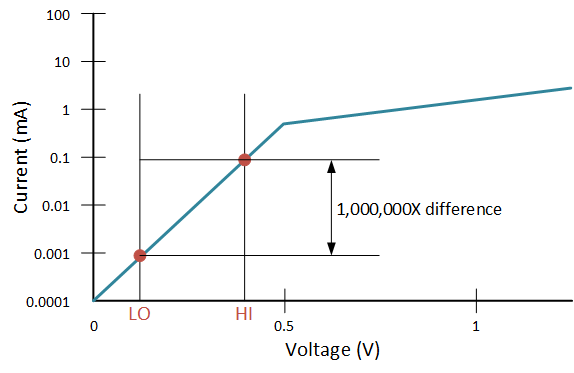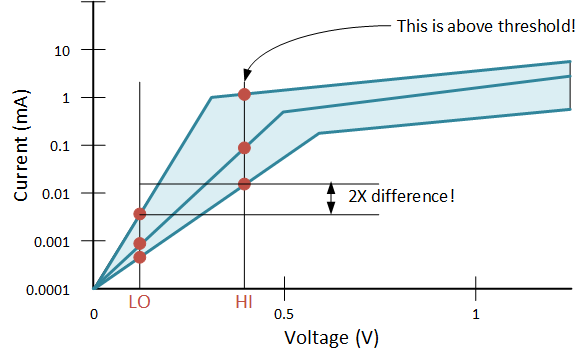
[From the last episode: We saw that reducing voltagesVoltage is what gets electrons to flow. It's analogous to water pressure, which gets water to flow. Voltage is measured in units of "volts." to near or below the threshold voltageThe voltage at which a transistor starts to turn on. It’s technically "off" below that voltage, although it is still ever so slightly on. can help to lower powerThe rate of energy consumption. For electricity, it’s measured in watts (W)..]
In theory, we can use leakageThe very small amount of current that can flow through a transistor when it's "off." currentThe amount of electrical flow. Measured in amperes or amps (A). as a way of helping us do logic, telling 1s from 0s. We know that because we saw last week that, as long as we have a big difference between the current at a logic low and the current at a logic high, then we have a way of distinguishing the two levels.
That’s great, but it’s overly simplistic. We showed a graph (simplified, with made-up numbers, but otherwise to the point) where we could go between two voltages, both below threshold, and have two current levels a million times apart. That looks like a good start.

But back when we talked about in-memory computing for machine learningMachine learning (or ML) is a process by which machines can be trained to perform tasks that required humans before. It's based on analysis of lots of data, and it might affect how some IoT devices work., we talked about process variation. That’s the issue where two different transistors are likely to differ in minute ways. In some cases it might be differences between transistors made in one lot today and another lot made yesterday. Or it could be the difference between transistors on two different wafersIn the context of making circuits, sensors, and actuators, a thin, round slice of pure silicon. Multiple devices will be made on it; it will then be sliced up to separate the individual chips. in a single lot. Or it might be the difference between transistors on different dice on a single wafer. Or it might be the difference between transistors on different parts of the same die.
In other words, you pretty much have to assume that two transistors that otherwise look the same may behave differently, even if only slightly.
That makes for a harder design job, since you can’t count on “this is how it will behave.” You have to take into account that “Well, it’s going to behave somewhere kinda around here, although we can’t count on a specific number for all transistors.”
It’s Worse for Sub-Threshold
While this can cause challenges for standard circuits, it’s a particular problem for sub-thresholdCircuits done where an active transistor works below the threshold voltage. circuits. That leakage regime can vary all over the place.
The chart below shows a simplified, conceptual picture of what we’re talking about. There are three curves on there: the middle one is the one we already saw. But there’s one to the left and one to the right, and any given transistor could behave anywhere between those extremes.

This shows what that kind of variation can mean. For one thing, the left-most curve has what we picked as our logic high actually being above threshold, even though it’s below threshold for the other curves. That could be a problem. In addition, our “million times apart” thing doesn’t look so good anymore. The difference between high and low on any given transistor still looks fine, but here’s the thing: a designer can’t design for just one of those transistors – it has to design for whichever one ends up in the circuit. And he or she can’t control that.
So, for instance, the “LO” value on the left curve is pretty close to the “HI” value on the right curve. So, while things looked a million times apart for one transistor, when you take them all into account, we’re looking at… guessing from the chart… maybe 0.005 mA for a low and 0.01 mA for a high – and that’s only 2X apart, way down from a million. (Yes, I’ve made up these numbers, but the point they make is accurate.)
And when you start taking changes in temperature or subtle supply-voltage changes into account, it just gets worse.
Not Impossible – Just Hard
This doesn’t mean that it can’t be done. It just makes it a lot harder. First, engineers have to study transistors in this region way more carefully than they used to (because it didn’t matter as precisely back then). Then they need really good design techniques that help to corral all of this variation and make the problem solvable.
So this style of design is far more specialized than your average logic design. Some companies make it their business; others quietly use it in addition to other techniques to keep power down.
Now that we’ve talked about voltage for a while here, it’s not the only thing that affects power. We’ll look at another contributor next week.

Leave a Reply